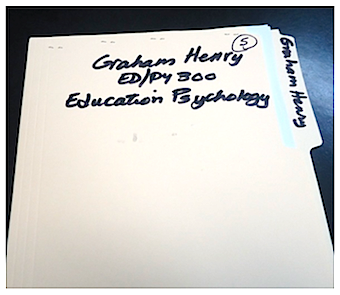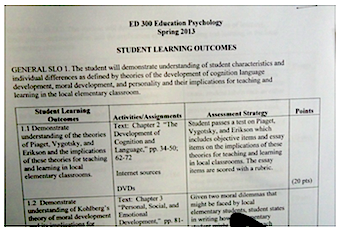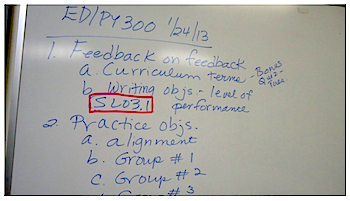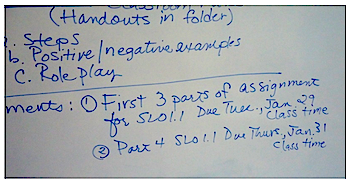Assessment
"The greatest barrier to success is the fear of
failure." ~ Sven Goran Eriksson
Summary of How Students are Informed of SLOs in My Classes
I typically teach ED 330 Classroom Management, ED/PY 300 Education Psychology, ED 301b Reading Methods, and courses as part of the UOG/COM-FSM BA Partnership Program including ED 489 Evaluation, ED 486 Building Effective Strategies for Teaching, and ED 334 Solving Discipline Problems. For the past eleven (11) years I have used the system summarized in this paper to ensure that students in these classes are aware of the SLOs (formerly known as objectives) in each class.
The SLOs for each course are included in the syllabus which is provided to students and discussed on the first day of class. Each student is provided with a folder with the SLOs stapled in the folder along with the assignment associated with each assessment strategy and the accompanying point value of each. Students insert assignments in the folders and leave the folders in the classroom after each class; they retrieve the folders at the beginning of the following class period with graded assignments inserted. Points are recorded in the student folders so students can determine their grades at any given time during the course. Below are pictures of the outside and inside of one folder being used this semester.
 Student folder – ED/PY 300
Spring 2013 Student folder – ED/PY 300
Spring 2013 |
 Inside student folder – ED/PY 300 Spring 2013 |
Prior to the start of each class a list of the activities and topics to be included in that class period is written on the board. Embedded in each list are references to the SLO(s) to be learned that day. At the bottom of each list is a summary of the assignments associated with the SLO(s). Below are pictures of the list of activities and associated assignments with the embedded SLO.
 List of activities for ED/PY 300
class on board List of activities for ED/PY 300
class on board |
 List of assignments for ED 330 class on board (SLO) |
Each assignment or exam in each class is linked to the associated SLO of the course syllabus. An example from a fall class is shown below.

Performance Assessment
Directions: You have been assigned to a group of 3 or 4 classmates. Each group will conduct research and create a poster to depict a topic related to motivation. The poster should not simply summarize the topic in writing. Instead, be creative. Use pictures, diagrams, and/or highlighted key words to use as a basis for sharing your topic with the class. Use the text, but also search the Internet for additional information on your topic. The topics, groups, and scoring rubric follow. All members of a group will be awarded the same number of points. You are encouraged to do your part to contribute to the work of your group. Be prepared to present your topic to the class on Tuesday, November 24, 2011.
| Group |
Members |
Topic |
| 1 |
Cassandra, Sernida, Yvonne, Arleen |
Intrinsic and Extrinsic Motivation |
| 2 |
Serlynn, Aileen, Ruth, Cheryl |
Expectancy X Value Theory |
| 3 |
June, Nancylynn, Steward, Juleen |
Maslow's Theory |
| 4 |
Jayceleen, Janet, Kimberly, Gracelyn |
Vygotsky's Theory of Motivation |
| 5 |
Carter, Donia, Dexter |
Piaget's Theory of Motivation |
| 6 |
Agatha, Yasko, Monaliza, Brian |
Skinner's Theory of Motivation |
Scoring Rubric
| Criteria |
Very
Good (3 pts.) |
Good (2 pts.) |
Fair (1 pt.) |
Poor (0 pts.) |
| Key
points |
Poster and
presentation cover all points |
Poster and
presentation cover most key points |
Poster and
presentation cover some key points |
Poster and
presentation fail to cover key points |
| Creativity |
Very
creative poster |
Creative
poster |
Somewhat
creative poster |
Poster
not creative |
| Presentation |
All members
presented |
Only two members
presented |
Only one member
presented |
N/A |
| TOTAL
/ 9 |
||||
Course level assessments are linked to each SLO of the syllabus (and course outline). These course level assessments are on file with the Dean of Academic Programs and are used to improve the student learning in subsequent offerings of the course. An example is the teaching of SLO 3.1 of the ED/PY 300 course first in the Spring 2013 semester because of poor student performance on this SLO in the Fall 2013 course and comments on student reflection papers that indicated that insufficient time and attention was devoted to this SLO in the course due to the fact that the SLO appears during the last part of the syllabus.
NOTE:
I wish to thank Professor Sue Moses
for granting permission to publish her work on assessment of SLOs in
this web site.
Rafael
Pulmano
2-9-2013
2-9-2013
Related topics
- Survey: Students'
Awareness of SLOs by Dr. Allain
Bourgoin
- Why statistics and what will you learn? by Professor Dana Lee Ling
- Survey: COM-FSM Student Awareness of SLOs by Associate Professor Ross Perkins
- Student Knowledge on SLOs by Rafael Pulmano
- Achieving SLOs Through Collaborative Learning by Rafael Pulmano
This page does not reflect an official position of the College of Micronesia-FSM
© 2017 Rafael A. Pulmano. Design by Andreas Viklund | Modified by Jason Cole
